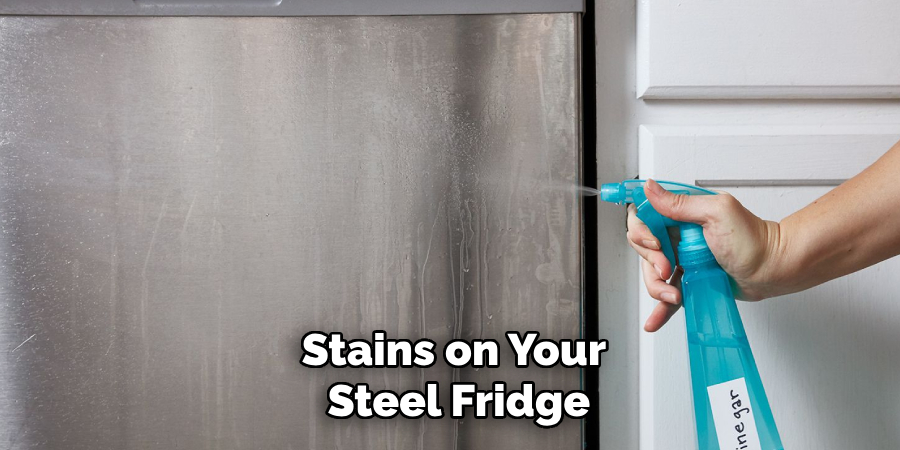Keeping a steel fridge clean is essential for maintaining its sleek and modern appearance and ensuring proper hygiene in your kitchen. Stainless steel appliances, while durable and corrosion-resistant, are particularly prone to issues such as fingerprints, smudges, food stains, and grease buildup.
These stains can be unsightly and may even harbor bacteria if left unattended. Understanding how to clean steel fridge surfaces effectively can save you time and frustration while preserving the appliance’s polished look. This guide is designed to help you tackle these challenges with ease, providing a step-by-step method for cleaning your fridge’s interior and exterior.

Whether you’re dealing with daily smudges or tougher stains, this article will equip you with the tools, techniques, and tips to keep your steel fridge sparkling clean and in top condition.
Tools and Materials Needed for Cleaning a Steel Fridge
Basic Cleaning Tools
To clean a steel fridge effectively, you’ll need a few essential tools to ensure a thorough yet gentle cleaning process. Microfiber cloths are indispensable for wiping down surfaces without leaving scratches or lint behind. Soft sponges and non-abrasive scrubbers are also ideal for removing grime and stains while protecting the steel’s finish. Additionally, you’ll require a bucket or spray bottle to hold your cleaning solutions, making applying them evenly across the fridge’s surfaces easier. These tools are practical and ensure that your fridge maintains its sleek and polished appearance.
Cleaning Solutions
Choosing the right cleaning solutions is key to achieving a spotless steel fridge. A simple DIY option is a mixture of mild dish soap, white vinegar, and water—this combination is both effective and non-toxic. For added shine, you may consider using a commercial stainless steel cleaner or polish specifically designed to enhance the steel’s luster. For tougher stains or odors, baking soda is a versatile solution. Mixing a baking soda paste with water will help lift stubborn stains while neutralizing unpleasant smells, leaving your fridge clean and fresh.
Preparing the Steel Fridge for Cleaning
Emptying the Fridge
To ensure a thorough cleaning, start by emptying the fridge. Remove all food items and place perishable goods in a cooler with ice packs to keep them fresh while you clean. Next, take out shelves, drawers, and trays, as these components need to be cleaned separately for better results. If you are cleaning the fridge coils or any parts near electrical components, unplug the fridge first to prevent any electrical hazards. Properly emptying the fridge sets the stage for an effective cleaning process and ensures no areas are overlooked.

Gathering Cleaning Supplies
Preparing your cleaning supplies beforehand will make the process smoother and more efficient. Gather tools such as microfiber cloths, sponges, and a bucket or spray bottle. Choose your cleaning solution based on what works best for your needs. A simple mix of vinegar and water is highly effective for general cleaning, or you can opt for a commercial stainless steel cleaner for added shine. If stubborn stains or odors are present, prepare a baking soda paste to address these specific issues. By organizing all your supplies in advance, you’ll save time and effort during the cleaning process.
How to Clean Steel Fridge: Step-by-Step Guide
Cleaning the Exterior of the Fridge
To begin cleaning the exterior of your steel fridge, start by wiping down the surface using a microfiber cloth dampened with a vinegar-water solution. This method is effective at removing grime and gentle enough to maintain the steel’s finish. Always follow the steel’s grain when cleaning to prevent streaks and ensure a smooth, polished appearance. For additional shine, apply a commercial stainless steel cleaner or polish with a soft cloth for a streak-free finish. Smudges and fingerprints tend to accumulate on stainless steel, especially around high-contact areas; gently remove these marks with a soft, dry cloth.
Regularly cleaning the exterior with these techniques lets you keep your fridge looking sleek and free of smudges, providing a cleaner and more hygienic kitchen environment.
Cleaning the Door Handles and Edges
Due to frequent contact, the door handles and edges of the fridge often collect dirt, grease, and fingerprints. To clean these areas effectively, use a damp cloth and a mild soap solution, gently scrubbing away any grime or food residue. Pay extra attention to corners, edges, and the undersides of handles, as dirt can accumulate in these spots. Once cleaned, dry the handles and edges thoroughly using a clean cloth. This step is crucial to prevent water spots from forming or rust developing in the long run. You may use a small amount of steel polish for stainless steel handles to enhance their shine and maintain their durability.
Regular attention to these high-contact areas will keep your fridge looking spotless and ensure a more hygienic surface for daily use.
Cleaning the Interior of the Fridge
The interior of your fridge should also be cleaned thoroughly to ensure food storage areas are safe and hygienic. Begin by wiping down the shelves, drawers, and trays with warm water and mild dish soap. Remove any sticky spills, crumbs, or stains, especially in corners and crevices that may be harder to reach. For tougher stains or unpleasant odors, apply a baking soda paste directly to the affected areas, gently scrubbing until the stains are lifted. Rinse thoroughly with a clean, damp cloth to remove any residue. Don’t forget to clean the door seals, which can accumulate debris or mold over time.
Use a damp cloth to wipe the seals carefully, ensuring they stay intact for proper fridge sealing. A clean interior extends the life of your fridge and keeps your food stored in a safe environment.

Dealing with Tough Stains or Odors
Using Baking Soda for Stubborn Stains
Baking soda is an excellent, eco-friendly solution for addressing tough stains on your steel fridge. To create a baking soda paste, simply mix a few tablespoons of baking soda with enough water to form a thick, spreadable consistency. Apply the paste directly to the stained areas and allow it to sit for about 10-15 minutes.
This resting period gives the baking soda time to break down the stain. Once the paste has been set, gently scrub the area with a non-abrasive sponge in circular motions. Rinse the spot thoroughly with a damp cloth and dry the surface with a microfiber cloth to ensure no residue is left behind. This method effectively removes stubborn stains while being safe for the steel’s finish and interior surfaces.
Eliminating Odors
Place an open box of baking soda on one of the fridge shelves to combat unpleasant odors. Baking soda naturally neutralizes odors, helping to keep your fridge smelling fresh. For a more proactive approach, clean the interior surfaces with a mixture of water and white vinegar. Use a damp cloth to wipe down all interior walls, shelves, and drawers, focusing on areas with lingering odors. This vinegar-water solution eliminates unpleasant smells and leaves your fridge feeling fresh and clean. Regular odor maintenance ensures a hygienic and pleasant food storage environment.
Cleaning the Fridge Coils and Vents
Locating and Accessing the Coils
Proper maintenance of your fridge coils is essential for ensuring energy efficiency and preventing overheating. Fridge coils are typically located either on the back or underneath the appliance. To access them, consult your user manual to confirm their exact location. If the coils are on the back, carefully move the fridge away from the wall, ensuring that it does not damage the floor. For coils underneath, detach the protective grille or kick plate at the bottom of the fridge. Once exposed, inspect the coils for dust, lint, or debris that may have accumulated over time.
Use a vacuum with a brush attachment to remove loose dirt effectively, and gently scrub any stubborn debris with a coil-cleaning brush. Cleaning the coils every six months can significantly improve your fridge’s performance and reduce energy consumption.
Cleaning the Vents
Maintaining clean vents or air intake areas is equally important to ensure proper airflow and optimal cooling efficiency. Begin by locating the vents, which are typically found inside the fridge near the back wall or sides.
Gently wipe down the vent covers with a damp microfiber cloth to remove surface dust and grime. For deeper cleaning, use a vacuum cleaner with a soft brush attachment to clear away any trapped debris. Avoid blocking vents with food items to maintain unrestricted airflow. Regular vent cleaning ensures that your fridge operates efficiently, preventing unnecessary strain on its cooling system.

Preventing Future Build-Up
Regular Maintenance
To avoid grime and residue buildup, regularly wipe down your fridge’s exterior and handles with a damp cloth. This simple routine helps maintain a clean and polished appearance. Additionally, perform a deeper interior and exterior cleaning every few months. This includes addressing tougher stains, renewing the shine of stainless steel surfaces, and sanitizing storage areas. Regular maintenance ensures your fridge stays efficient, hygienic, and visually appealing.
Tips for Keeping the Fridge Smelling Fresh
To keep your fridge smelling fresh, place an open box of baking soda or a pouch of activated charcoal inside to naturally neutralize odors. For maximum effectiveness, be sure to replace these deodorizers every one to three months. Additionally, ensure that food is properly covered and stored in airtight containers to prevent spills and odors from spreading. These practices help maintain a clean and pleasant-smelling storage environment.
When to Seek Professional Help
Major Damage or Rust
If the steel surface of your fridge has significant rust spots or permanent stains that cannot be removed despite thorough cleaning, it is advisable to consult a professional. Experts can assess the damage and recommend solutions, such as refinishing or replacing certain parts, to restore your fridge’s appearance.
Mechanical Issues
If your fridge is experiencing mechanical problems, such as poor cooling performance, unusual noises, or water leaks, it may require professional maintenance or repairs. These issues often indicate underlying problems with the appliance’s components, which a qualified technician should address to prevent further damage.

Conclusion
Learning how to clean steel fridge surfaces effectively ensures your appliance remains both functional and aesthetically pleasing. Each step contributes to the fridge’s overall efficiency and longevity, from wiping down the exterior and carefully cleaning seals to using baking soda for tough stains and maintaining clean coils and vents. Regular cleaning not only prevents grime and odors but also supports better hygiene for food storage. Consistent maintenance will keep your fridge looking great and performing optimally over time, making it essential to a tidy and organized kitchen.
Edmund Sumlin is a skilled author for Metal Fixes, bringing 6 years of expertise in crafting a wide range of metal fixtures. With a strong background in metalwork, Edmund’s knowledge spans various types of fixtures, from decorative pieces to functional hardware, blending precision with creativity. His passion for metalworking and design has made him a trusted resource in the industry.
Professional Focus:
- Expert in Metal Fixtures : Edmund aesthetic specializes in creating durable and innovative metal fixtures, offering both appeal and functionality. His work reflects a deep understanding of metalworking techniques and materials.
- Sustainability Advocate : He is dedicated to using sustainable practices, ensuring that every fixture is crafted with eco-friendly methods while maintaining high-quality standards.
In his writing for Metal Fixes, Edmund provides valuable insights into the latest trends, techniques, and practical advice for those passionate about metal fixtures, whether they are professionals or DIY enthusiasts. His focus on combining artistry with engineering helps others discover the true potential of metal in design.


